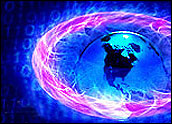
From billboards to clothing racks, electronic sign makers have paper products in their crosshairs.
Among the technologies threatening paper’s signage dominion are super juiced LEDs (Light Emitting Diodes) and electronic inks and papers.
Billboards have long been ripe for electronic alternatives, but nature, in the form of the sun, has been a major challenge to sign makers, especially those trying to create an LED alternative to the printed message.
Can’t Compete With Sun
The brightness of the sun is around 6,500 nits. A nit is a unit used to measure brightness. Computer monitors, for example, are in the 300 nit range. A typical LED billboard is in the 5,000 to 6,000 nit ballpark. If an electronic billboard isn’t brighter than 6,500 nits, it’s in trouble.
“The number one complaint about LED billboards by existing operators is that they’re not bright enough in direct sunlight,” Tony Materna, president of Visioneered Image Systems (VIS) of Garden Grove, Calif., told TechNewsWorld.
However, what VIS has done is create a patented technology that uses a light-shaping diffracted defuser to more than double the brightness of an LED billboard to 14,000 nits.
Longer Lasting Loafers
Since the company’s billboards are so bright, it can address another complaint about LED signs: they degrade over time.
“Because we can be twice as bright as daylight, we don’t have to run a sign all the time at 14,000 nits,” Materna explained. “In fact, most of the time we can run them at 6,500 nits, which is like loafing for them.
“Degradation is directly related to how hard you drive the LEDs,” he continued. “So our signs can last longer.”
He noted that a typical LED billboard is down to 50 percent power, or around 3,000 nits, in 2.5 to three years. “It takes us five to six years to get to 6,500 nits,” he said.
Five Year Warranty
Materna added that every pixel on a VIS sign has a photo detector in it. That’s used to calibrate the sign at the factory and to recalibrate the sign to those factory settings in the field.
“Because we have this huge overhead — twice as bright as daylight — we can use it over time to keep correcting the LEDs,” he noted. “So our signs have no visible degradation.
“In fact, we’re shipping our signs with an industry first: a five year warranty with no visible degradation — no turning pink, no splotchiness, no tiling — perfect image quality for five years,” he boasted.
Skyrocketing Revenues
While Materna wouldn’t cite specific prices for VSI’s billboards, he maintained that operators are willing to pay a premium for an effective electronic solution.
“In almost every case we know of in North America where they have converted a fixed print static billboard to an electronic, they’ve increased the revenue for that site by a factor of seven or more,” he contended.
Digital ink is also being considered as a medium for billboards. Magink Display Technologies, of Israel, has raised US$50 million to date to advance its reflective digital ink technology.
Electronic Ink
On a smaller scale, companies like E Ink in Cambridge, Mass. and Xerox, in Stamford, Conn. are experimenting with using e-ink for in-store signage.
Electronic ink creates a paper-like experience by placing electronic dots on a thin plastic film. In E Ink’s case, an electric charge can be used to toggle the dots between black and white. In Xerox’s technology, the dots are actually small balls — half black, half white — that are rotated to create a message.
E Ink spokesperson Jennifer Haight explained that some of the company’s partners have begun selling point-of-sale signs using e-ink to retailers in Asia.
The signs incorporate both words and motion, she noted. “Motion stops people; it attracts them,” she told TechNewsWorld. “It gives retailers the ‘pause effect’ they’re looking for with these signs.”
Licensing E-Paper
Although initially gung-ho about its “electronic paper” technology, Xerox appears to be retreating from the market. Last December it shut down Gyricon, a company it formed to advance the technology, and is currently shopping the product to potential licensees.
“While there is still promise for electronic paper opportunities, the retail signage market isn’t something Xerox wishes to continue in,” Xerox spokesperson Bill McKee told TechNewsWorld. “It’s not part of our core business, and that’s why we chose to shut it down.
“We’re looking for someone to take the intellectual property, license it from Xerox and move it to a new level,” he added.





















































